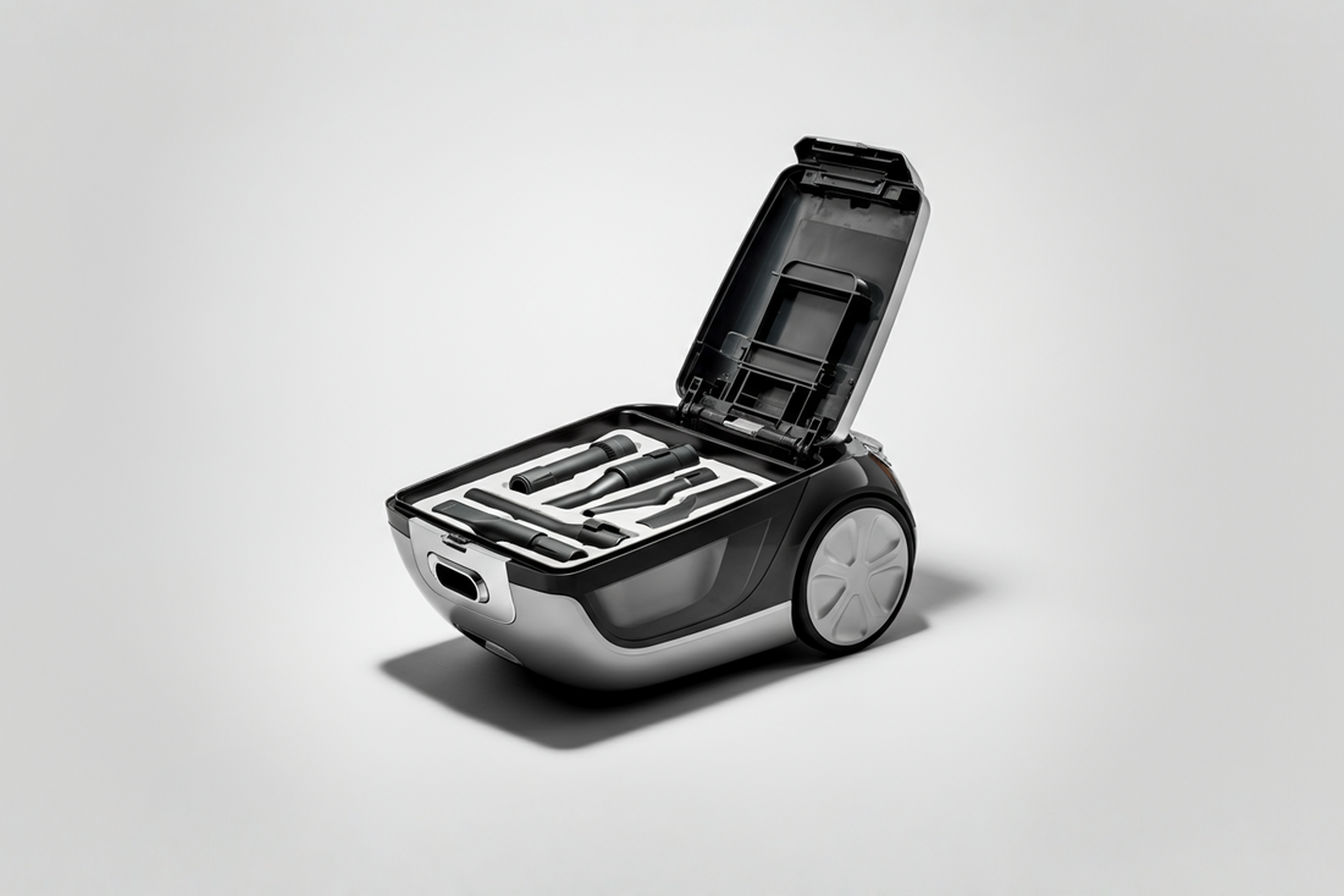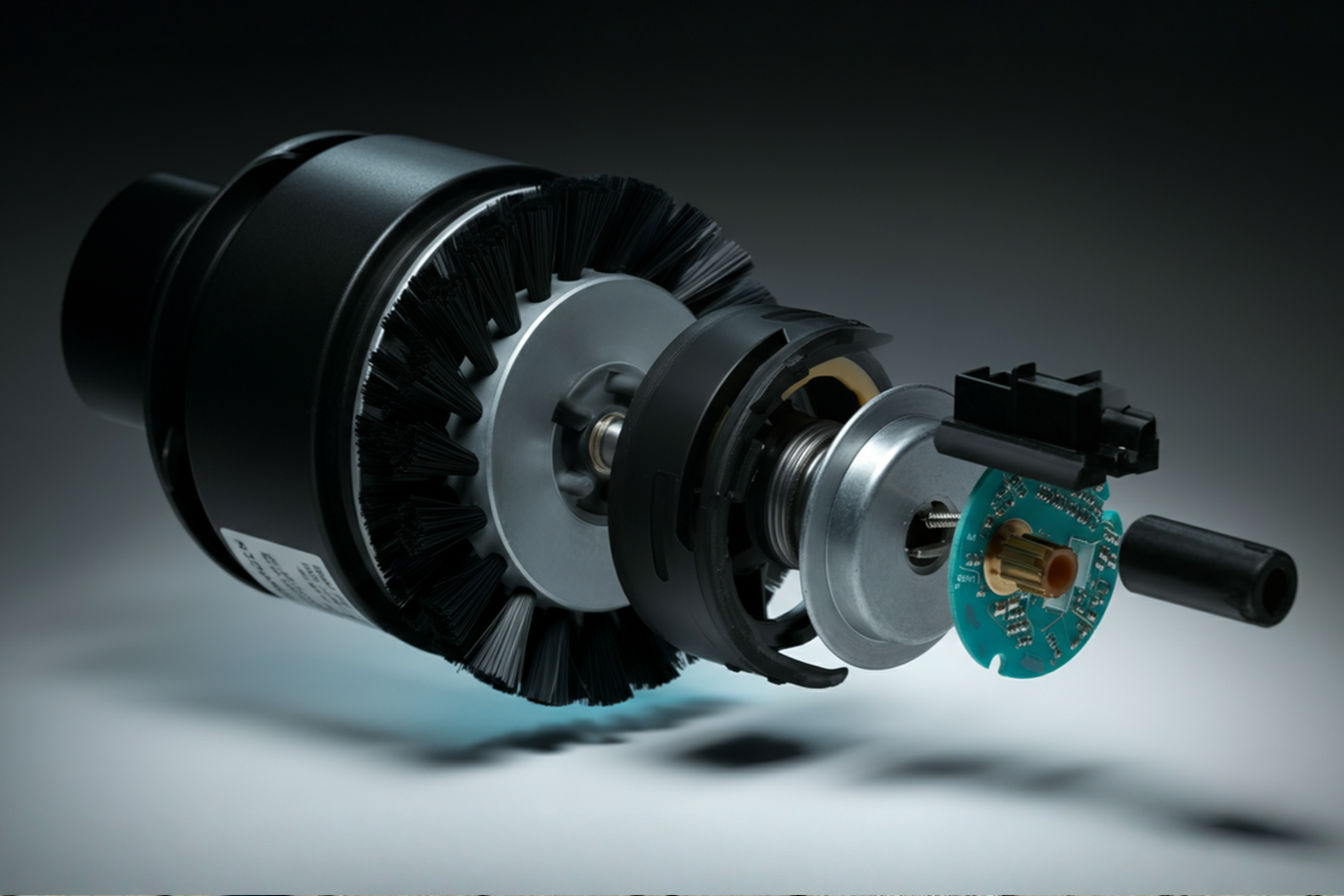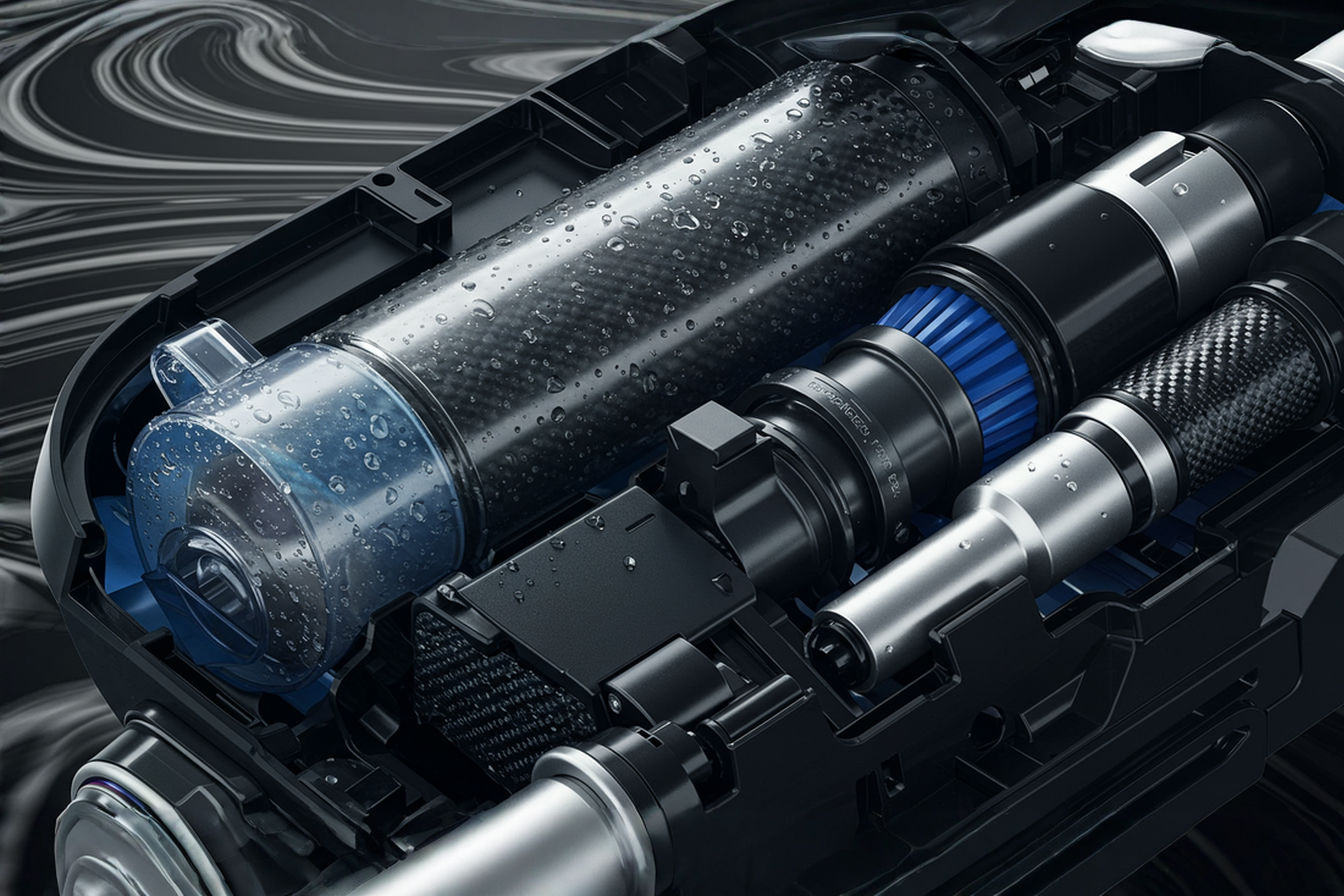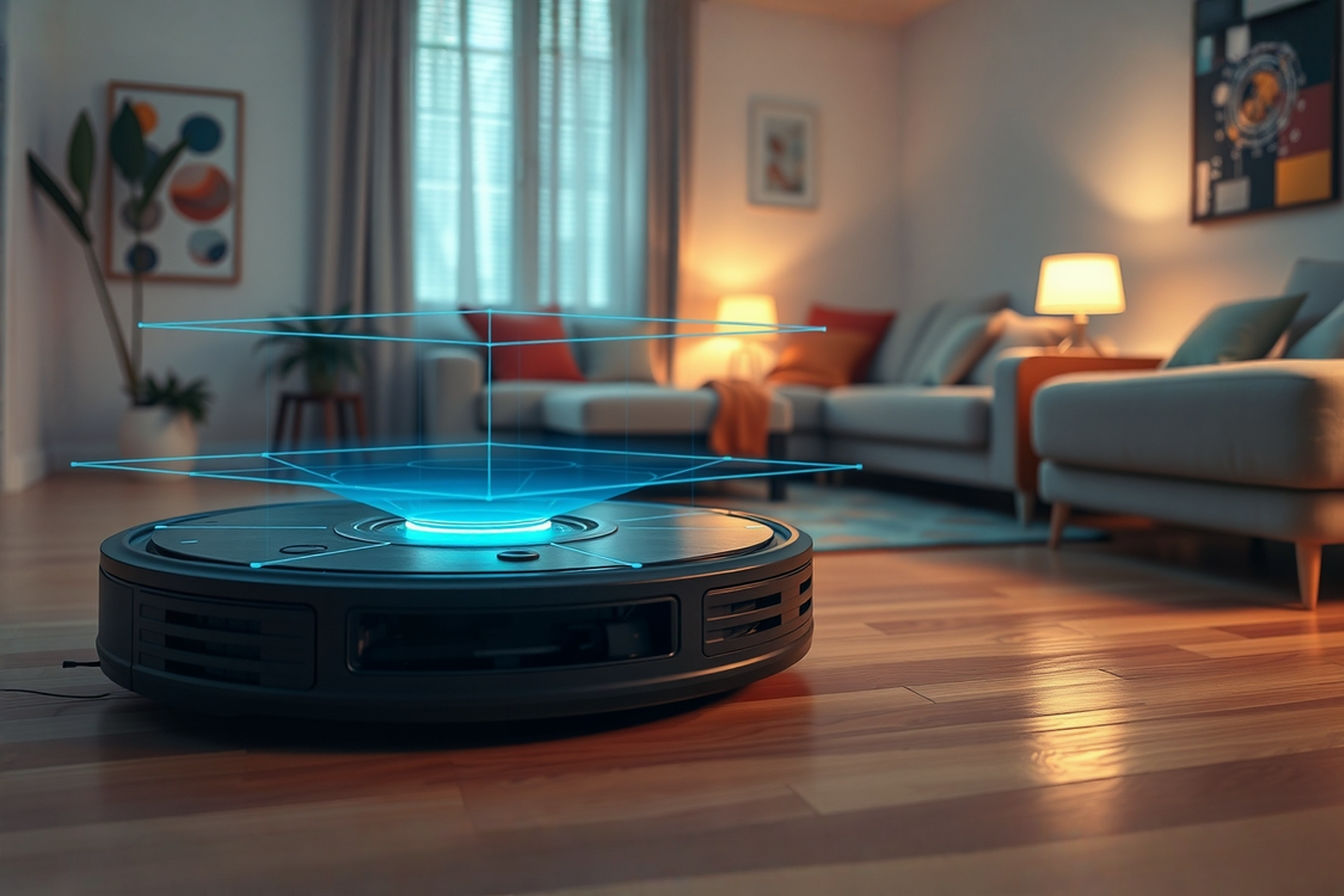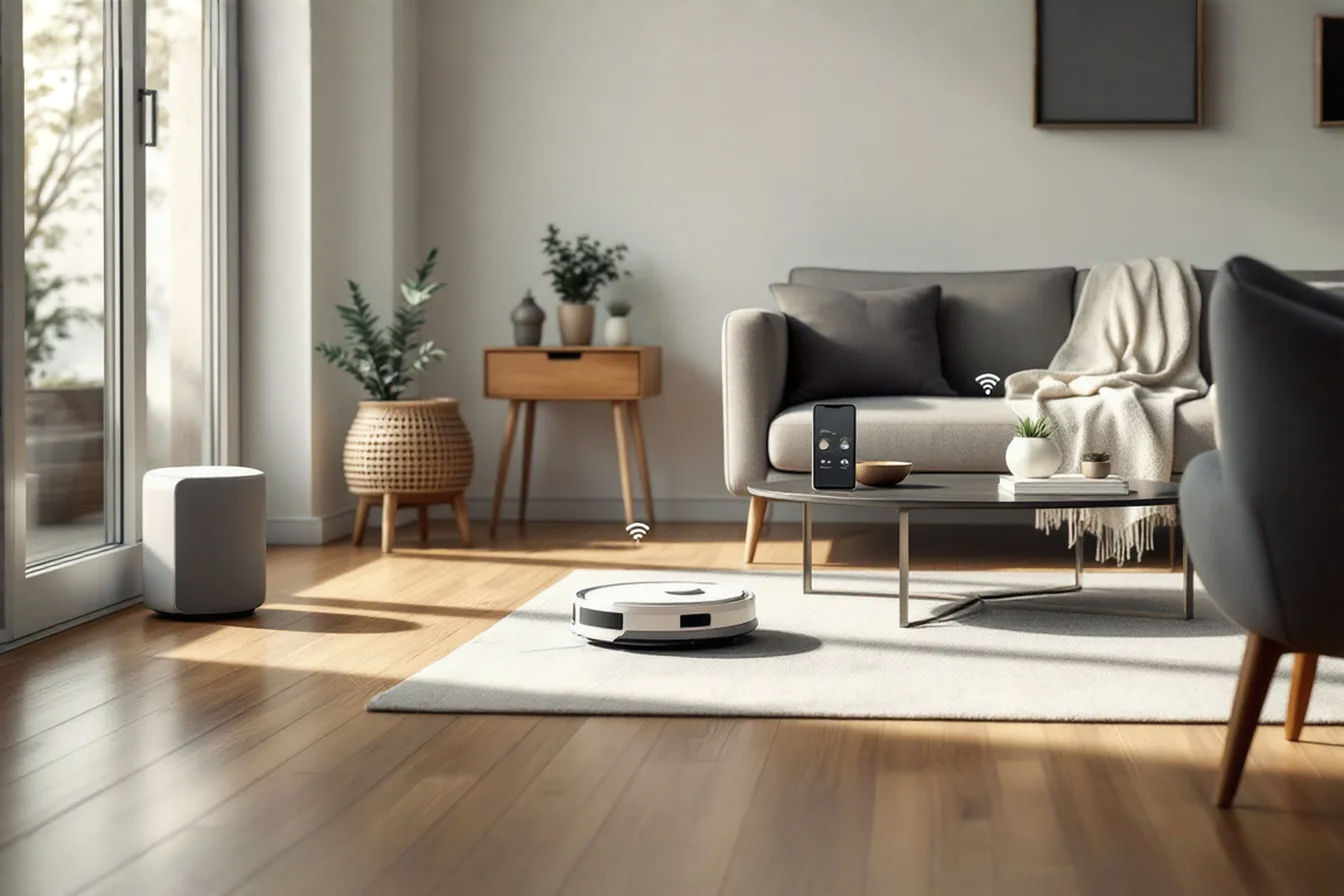Integrated Vacuum Cleaner Storage Evolution: How On-Board Tool Design Improved Usability
From separate boxes to sophisticated on-board systems, the evolution of vacuum tool storage represents a fascinating journey in design that revolutionized cleaning efficiency.
This post may contain affiliate links. If you make a purchase through these links, we may earn a commission at no additional cost to you.
When the first vacuum cleaners rumbled into homes in the early 20th century, they were revolutionary yet remarkably simple machines. These early models focused primarily on the fundamental suction mechanism with little thought given to accessories or their storage. Fast forward to today, and the modern vacuum cleaner comes equipped with an arsenal of specialized tools designed to tackle every cleaning challenge imaginable—from crevice tools that reach tight corners to pet hair brushes designed specifically for animal dander.
The journey from those rudimentary machines to today’s sophisticated cleaning systems reveals a fascinating evolution not just in cleaning power, but in a critical yet often overlooked aspect of design: integrated tool storage. This seemingly minor feature has fundamentally transformed how we interact with vacuum cleaners, dramatically improving their usability and effectiveness.
The evolution of vacuum cleaner storage systems—from separate boxes to fully integrated on-board solutions—represents a perfect case study in how thoughtful design improvements can revolutionize everyday appliances. This progression didn’t happen overnight but evolved through decades of innovation, user feedback, and technological advancement.
This article traces that evolution, examining how the seemingly simple challenge of “where to put the tools” led to remarkable innovations that changed an entire industry and made cleaning more efficient for millions of households worldwide.
The Early Days: External Storage Solutions
Separate Lives: Vacuum Cleaners and Their Distant Accessories
The first household vacuum cleaners of the early 20th century, like the 1908 Hoover Model O or the early Electrolux models of the 1920s, were revolutionary for their time but painfully primitive by today’s standards. These machines focused on the fundamental suction mechanism, with accessories considered secondary afterthoughts.
During this era, vacuum attachments typically came in separate wooden or cardboard boxes that users stored away from the machine itself. These boxes contained a basic set of tools: usually a crevice tool for corners, perhaps a small brush for upholstery, and occasionally a floor attachment for different surfaces.
Howard Nourse, vacuum cleaner historian and author of “The Vacuum Cleaner: A History,” notes: “Early vacuum cleaners were sold as complete ‘systems,’ but the reality was that the tools and the machine led separate lives. The attachments were cumbersome, and storage was completely disconnected from the device itself.”
The Practical Challenges of External Storage
This separation created several significant problems for users:
- Accessibility issues: When users needed to switch from cleaning floors to tackling cobwebs in corners, they had to stop, locate the separate storage box, find the right attachment, and then continue cleaning.
- Lost accessories: Detached storage inevitably led to misplaced accessories. A 1947 consumer survey by Home Efficiency Magazine found that over 65% of vacuum owners reported losing at least one attachment within the first year of purchase.
- Storage space consumption: The separate boxes required additional storage space in already crowded closets or utility rooms.
- Reduced usage of attachments: Most significantly, the inconvenience meant many consumers simply didn’t use the specialized tools, defeating their purpose entirely. A 1955 market research study by Consolidated Edison found that nearly 70% of vacuum owners rarely or never used their attachments.
The Financial Impact
For manufacturers, this situation created a paradox. Companies spent considerable money developing specialized tools that improved cleaning effectiveness. However, these accessories were being underutilized due to storage inconvenience, leading to consumer dissatisfaction with overall cleaning performance.
Additionally, replacement accessories became a small but profitable side business, with manufacturers charging premium prices for lost tools. While profitable in the short term, this model ultimately frustrated consumers and limited the perceived value of vacuum systems.
The disconnection between vacuum cleaners and their tools represented a fundamental design flaw that would take decades to fully address.
The Transition Period: Semi-Integrated Approaches
Post-War Innovation: The First Steps Toward Integration
The post-World War II economic boom created intense competition in the home appliance market. Manufacturers began looking for ways to differentiate their products and address consumer pain points. Storage integration emerged as one such opportunity.
By the mid-1950s, companies like Hoover, Eureka, and Electrolux began experimenting with rudimentary attachment carriers. These early solutions weren’t truly integrated but represented the first steps toward keeping tools with the vacuum itself.
The 1956 Hoover Constellation, for example, featured a ring of clips around its spherical body where users could attach tools. While primitive by today’s standards, this represented a significant conceptual breakthrough—the idea that tools should travel with the vacuum.
Similarly, the Electrolux Model G of 1957 featured a small carrier that could be attached to the canister body or wall-mounted near where the vacuum was stored. These semi-integrated approaches still required manual attachment of the carrier to the machine, but they kept the tools and vacuum together as a system.
Material Innovations Enable New Possibilities
The transition period coincided with significant advances in plastics technology. New polymers allowed manufacturers to create lightweight, durable tool holders that wouldn’t add significant weight to the vacuum cleaner.
Vacuum engineer Thomas Reynolds, who worked at Eureka during this period, explained in a 1975 industry publication: “The development of injection-molded ABS plastic was a game-changer. Before this, we were limited to metal components that were too heavy or brittle plastics that wouldn’t survive daily use. These new materials opened up design possibilities we’d only dreamed of.”
By the 1960s, several manufacturers had developed vacuum models with rudimentary tool holders molded directly into the bodies or hoses of their machines. The 1964 Hoover Portable, for instance, featured a small compartment in its body that could hold two accessories.
Challenges of Early Integration
These early integration attempts faced several technical challenges:
- Weight distribution: Adding tools to the vacuum body created balance issues that affected maneuverability.
- Attachment security: Early clip systems often failed to hold tools securely, leading to accessories falling off during use or transport.
- Limited capacity: Space constraints meant only a few tools could be carried on-board.
- Access difficulties: Tools were sometimes integrated in locations that made them awkward to remove or replace during cleaning.
Despite these limitations, consumer response was overwhelmingly positive. A 1965 consumer satisfaction study conducted by General Electric found that models with any form of on-board storage rated 30% higher in user satisfaction than those without, even when suction power and cleaning performance were identical.
Case Study: The Hoover Dial-A-Matic Revolution
Perhaps the most significant breakthrough of this transition period came with the 1963 introduction of the Hoover Dial-A-Matic upright vacuum. This innovative model featured tool storage built directly into the back of the vacuum body, with a specialized caddy that held multiple attachments.
“The Dial-A-Matic represented our first comprehensive attempt to solve the storage problem,” noted Harold Thompson, former Hoover design chief, in a 1970 interview. “We recognized that storage wasn’t just a convenience feature—it was fundamental to the vacuum’s usability and effectiveness.”
The Dial-A-Matic’s success demonstrated consumer demand for integrated storage solutions and set the stage for the fully integrated systems that would follow in the coming decades.
The Modern Revolution: Fully Integrated Systems
The Birth of True Integration (1980s-2000s)
The 1980s marked the beginning of what we can consider truly modern integrated storage systems. Manufacturers shifted from viewing accessories as optional add-ons to seeing them as essential components of a complete cleaning system.
The breakthrough came when designers began planning for tool storage from the initial concept stage rather than adding it as an afterthought. This fundamental shift in thinking led to vacuum cleaners where the tools and their storage were intrinsic to the overall design.
The 1984 Electrolux Trilogy represented an early example of this new philosophy. The canister vacuum featured a dedicated compartment on top of the unit that housed a complete set of tools in custom-molded spaces. Each tool had a specific location, making it immediately obvious if an attachment was missing.
Industry Competition Drives Innovation
As the 1980s progressed into the 1990s, integrated storage became a major competitive differentiator in the vacuum cleaner market. Manufacturers raced to develop more comprehensive, user-friendly storage solutions.
Dyson’s entry into the market in the 1990s further accelerated this trend. The company’s DC01 upright vacuum featured clip-on tools attached to the vacuum’s wand, ensuring accessories were always available. Later Dyson models introduced innovations like the tool caddy that attached to the hose, keeping accessories within easy reach during cleaning.
By the early 2000s, virtually every major vacuum manufacturer offered some form of integrated storage. The market had shifted to where on-board storage wasn’t just a premium feature but an expected standard component.
Location Matters: Strategic Tool Placement
As storage integration matured, manufacturers discovered that the location of tool storage significantly impacted usability. Three main approaches emerged:
- Handle integration: Tools stored on or near the handle provided maximum accessibility during use but were limited in number due to weight considerations. The Shark Navigator series popularized this approach with tools mounted directly on the handle for grab-and-go convenience.
- Body integration: Storing tools in compartments within the vacuum body allowed for more attachments but sometimes reduced accessibility. Miele’s canister vacuums exemplified this approach with their VarioClip system and internal storage compartments.
- Hybrid approaches: Some manufacturers, like Bissell, developed systems that combined both locations, with frequently used tools on the handle and specialized attachments in body compartments.
Research by the Product Usability Research Consortium in 2005 found that handle-mounted tools were accessed approximately three times more frequently during cleaning sessions than body-stored attachments, though body storage allowed for a greater variety of specialized tools.
Material and Engineering Innovations
Modern integrated storage systems benefited from significant advances in materials science and engineering:
- Lightweight, high-strength polymers allowed for tool holders that didn’t add significant weight to the vacuum.
- Micro-molding techniques enabled precise fitting of tools into increasingly compact spaces.
- Magnetic systems provided secure attachment without complex mechanical latches.
- Memory materials allowed for flexible holding systems that could accommodate various tool shapes.
The Bosch Athlet vacuum, introduced in 2014, showcased how far materials had advanced. Its integrated accessory system used specialized polymers that securely gripped attachments without adding significant bulk, while memory materials in the holders automatically adjusted to different tool shapes.
Design Principles of Effective On-Board Storage
Ergonomic Considerations: The Human Factor
As integrated storage became standard, manufacturers turned their attention to optimizing the human-machine interaction. Ergonomic research revealed several key principles for effective tool storage:
- Tool retrieval paths should require minimal bending, reaching, or awkward movements.
- Visual accessibility is crucial—users should see at a glance what tools are available and which are missing.
- Cognitive load should be minimized through intuitive organization and clear visual cues.
- Hand clearance must be sufficient for users with various hand sizes and grip strengths.
Dr. Elena Korshova, ergonomics researcher at the Appliance Design Institute, explained: “The most elegant storage solution fails if it requires uncomfortable body positions or complex movements to access. Effective design considers the user’s physical comfort throughout the entire task flow.”
Weight Distribution: The Balance Challenge
Adding tools to a vacuum cleaner creates weight distribution challenges that can affect maneuverability and user fatigue. Designers must carefully consider how the added weight of stored tools impacts the vacuum’s handling characteristics.
For upright vacuums, higher-mounted storage can raise the center of gravity, potentially making the machine more likely to tip. Lower-mounted storage adds stability but may create accessibility issues. Canister vacuums face different challenges, as body-mounted tools can make the unit more cumbersome to pull around.
Dyson’s approach to this challenge involved distributing tools along the wand rather than concentrating them in one location. The Miele Complete C3 series took a different approach, placing tools inside the body but engineering the weight distribution to maintain the canister’s low center of gravity.
User Accessibility: Reach and Release
Accessibility involves not just where tools are stored but how easily they can be removed and replaced. Key factors include:
- Reach requirements: Tools should be accessible without excessive stretching or bending.
- Single-handed operation: Users should be able to retrieve most tools with one hand.
- Release mechanisms: Tools should detach easily but not accidentally fall off.
- Replacement guidance: Clear visual or physical cues should guide proper tool replacement.
The Shark Apex upright vacuum exemplifies thoughtful accessibility design with its tool caddy positioned at handle height, allowing users to access attachments without bending. Each tool socket includes subtle guide ridges that help the user correctly align the attachment when replacing it.
Visual Design: Communication Through Form
Effective storage systems communicate their function through thoughtful visual design. Color coding, shapes, and symbols help users quickly identify tools and their proper storage locations.
Miele’s color-coding system, for example, uses matching colored dots on both tools and their storage locations. Dyson employs shape-based guidance, with storage sockets that echo the profile of the tool they hold. Both approaches communicate proper tool placement without requiring conscious thought.
Visual design also extends to indicating when tools are properly secured. The audible “click” of a correctly seated attachment provides feedback that reinforces proper usage. Similarly, contrasting colors or exposed indicators can visually signal when an attachment isn’t fully secured.
Technical Innovations in Tool Design
Material Evolution: From Metal to Advanced Polymers
Vacuum cleaner attachments have undergone a remarkable material evolution that parallels the development of their storage systems. Early vacuum tools were primarily made of metal—usually aluminum or steel—making them durable but relatively heavy and inflexible in design.
The introduction of advanced polymers in the 1970s and 1980s revolutionized tool design. Modern attachments typically use a combination of materials:
- Acrylonitrile butadiene styrene (ABS) provides rigid structural elements with excellent impact resistance.
- Thermoplastic elastomers (TPE) create flexible edges that improve sealing against surfaces.
- Carbon fiber-reinforced polymers deliver exceptional strength in premium models without weight penalties.
- Silicone components offer heat resistance and flexibility in specialized tools.
This material evolution enabled more complex tool shapes while reducing weight by up to 70% compared to metal equivalents. Lighter tools, in turn, made on-board storage more practical by reducing the overall weight burden on the vacuum system.
Multi-functional Tools: Doing More with Less
A key innovation that supported integrated storage was the development of multi-functional tools that combined previously separate attachments. By reducing the total number of accessories needed, manufacturers could make comprehensive on-board storage more feasible.
The evolution of the combination floor tool illustrates this trend. Early vacuums required separate attachments for carpet and hard floors. Modern combination tools feature switch mechanisms that extend or retract brushes as needed, effectively providing two tools in one form factor.
Dyson’s introduction of the “combo tool” in the early 2000s exemplified this approach by merging upholstery and dusting functionality into a single attachment with a sliding brush collar. This innovation halved the storage space required while maintaining full functionality.
Quick-Release Mechanisms: The Connection Revolution
The interface between tools and vacuum has seen remarkable technical refinement. Early vacuum systems used threaded connections or friction fits that were secure but cumbersome to attach and detach. Modern systems employ sophisticated quick-release mechanisms that balance security with ease of use.
Miele’s SuctionCup interface, introduced in their Complete C3 series, exemplifies this innovation. The system uses a partial-twist locking mechanism with tactile feedback that confirms proper connection. This design allows for tool changes in seconds without complicated alignment requirements.
Similarly, Dyson’s “quick-release” button system enables single-handed tool changes without twisting or excessive force. The mechanism uses spring-loaded locking pins that engage automatically when the tool is inserted and disengage with a simple button press.
These connection innovations were crucial enablers for integrated storage systems, as they made it practical for users to frequently change attachments during cleaning sessions.
Universal Fitting Systems: Standardization Attempts
An interesting subplot in vacuum tool evolution has been the industry’s attempts at standardization. In the 1990s, several European manufacturers proposed a universal attachment standard similar to how electrical plugs are standardized in some regions.
The European Vacuum Association’s 1996 proposal for a Universal Attachment Interface (UAI) gained initial support but ultimately failed to achieve industry-wide adoption. Different vacuum designs—upright, canister, stick, and handheld—had divergent requirements that proved difficult to reconcile in a single standard.
Instead, most manufacturers developed proprietary connection systems optimized for their specific vacuum designs. Some, like Bosch and Siemens (both owned by BSH Home Appliances), shared connection standards across their brand families to enable accessory compatibility.
While full industry standardization remains elusive, the concept influenced modern designs. Many contemporary systems now feature adapter rings that allow attachments to work across multiple vacuum models within a manufacturer’s lineup.
Miniaturization: Compact Without Compromise
As cordless and stick vacuums gained popularity in the 2010s, tool design faced new miniaturization challenges. These slimmer vacuum formats had less space for tool storage, requiring more compact attachments without sacrificing functionality.
Engineers responded with clever space-saving designs:
- Telescoping extensions that collapse for storage but extend during use
- Folding mechanisms that reduce storage footprint by 40-60%
- Nested designs where smaller tools store inside larger ones
The Shark IONFlex cordless vacuum exemplifies this approach with its MultiFlex wand that folds in half for storage while providing full reach during use. Similarly, Dyson’s V-series vacuums feature a crevice tool that telescopes to double its length when needed.
These miniaturization efforts directly supported better integrated storage by reducing the space needed to carry a complete tool set on board the vacuum.
Specialized Tool Evolution
Crevice Tool Development: Reaching the Unreachable
The humble crevice tool—that narrow, angled attachment for cleaning corners and tight spaces—has undergone significant refinement in tandem with storage evolution.
Early crevice tools were simple straight tubes with flattened ends. Modern versions incorporate sophisticated design elements:
- Articulating heads that adjust to different angles
- Flexible portions that bend to navigate obstacles
- LED lighting in premium models to illuminate dark spaces
- Secondary brush elements that deploy for dusting within crevices
These enhancements improved functionality but created storage challenges due to more complex shapes. Manufacturers responded with innovative solutions like the Dyson “reach under” tool that combines a curved profile with a low-height design specifically engineered to fit in tight storage spaces.
Upholstery Brush Innovations: Surface Sensitivity
Upholstery tools have evolved from simple rectangular brushes to sophisticated attachments with multiple cleaning surfaces and adjustable features. Modern upholstery tools typically include:
- Lint strips or microfiber pads for capturing hair and fine particles
- Adjustable brush heights for different fabric types
- Edge channels that improve suction along furniture seams
- Anti-static materials that prevent fabric damage
These features necessitated more complex storage solutions. Miele addressed this challenge by developing a “park system” where the upholstery tool attaches to the vacuum body during storage but in a different configuration than during use, optimizing the space required.
Pet Hair Tool Evolution: Specialized Problem-Solving
Perhaps no specialized tool better illustrates the co-evolution of functionality and storage than the pet hair attachment. Non-existent in early vacuum design, these tools emerged as a category in the 1990s as manufacturers recognized the specific challenges pet owners faced.
Modern pet hair tools incorporate multiple technologies:
- Rubber bristles that create static electricity to attract hair
- Counter-rotating brushes that prevent hair wrapping
- Self-cleaning mechanisms that eject collected hair
- Specialized airflow channels that maintain suction when heavily loaded with hair
The complexity of these tools created storage challenges that drove innovation. Shark’s Pet Power Brush, for example, features a collapsible design that reduces its storage footprint by nearly 50% without compromising cleaning effectiveness when deployed.
Specialized Surface Tools: Material-Specific Design
As homes incorporated more diverse flooring materials, vacuum manufacturers developed increasingly specialized tools for different surfaces:
- Parquet tools with natural bristles for delicate hardwoods
- Plush carpet tools with adjustable height settings
- Tile and grout tools with stiff bristles for textured surfaces
- Area rug tools that adjust suction to prevent fabric pulling
This proliferation of specialized tools created a storage dilemma: how to provide users with the right tool for every surface without overwhelming the vacuum with attachments?
Some manufacturers addressed this through modular systems. Miele’s AllTeQ floor tool, for instance, accepts interchangeable inserts for different surfaces, allowing multiple specialized functions while requiring storage space for only one main tool body.
Impact on User Experience
Efficiency Improvements: Measurable Time Savings
The integration of tool storage into vacuum cleaners has had measurable impacts on cleaning efficiency. A 2015 study by the Home Cleaning Research Institute found that users with fully integrated tool storage completed multi-surface cleaning tasks 37% faster than those using vacuums with separate tool storage.
This improvement stems from several factors:
- Reduced setup time: Users spend less time gathering accessories before cleaning.
- Faster tool changes: On-board tools can be accessed and swapped within seconds.
- Greater tool utilization: When tools are readily available, users are more likely to use the appropriate attachment for each surface.
- Reduced interruptions: Cleaning sessions flow more naturally without pauses to search for tools.
Time-motion studies reveal that the average tool change with integrated storage takes approximately 8-12 seconds, compared to 45-90 seconds when tools are stored separately. For a typical cleaning session involving 5-7 tool changes, this represents significant time savings.
User Satisfaction: Beyond Convenience
Consumer satisfaction research consistently shows that integrated storage ranks among the top features influencing overall satisfaction with vacuum cleaners. A 2018 J.D. Power vacuum cleaner satisfaction survey found that storage integration was the third most important factor in user satisfaction, behind only cleaning performance and reliability.
Interestingly, this satisfaction effect extends beyond the practical benefits. Users report psychological benefits as well:
- Reduced anxiety about losing accessories
- Greater confidence in having the right tool for each task
- Increased perception of value from the vacuum system
- Satisfaction from organization and having a “complete” system
These psychological benefits help explain why integrated storage has become such a crucial competitive feature despite being technically simpler than many other vacuum innovations.
The Complete System Experience
Perhaps the most significant impact of integrated storage has been the evolution of vacuum cleaners from single-purpose machines to complete cleaning systems. Modern vacuums are no longer just suction devices but comprehensive tools designed to address various cleaning challenges throughout the home.
This evolution parallels changes in other household technologies. Just as smartphones evolved from simple communication devices to multi-functional tools, vacuum cleaners have transformed from floor-cleaning machines to versatile home care systems.
Consumer behavior researcher Dr. Melissa Chang explains: “When users perceive their vacuum as a complete system rather than just a machine with separate parts, they develop a different relationship with it. It becomes a solution rather than just a tool—something that solves cleaning problems rather than just performs a mechanical function.”
This perceptual shift has influenced how consumers use their vacuums and how manufacturers market them. Marketing materials now commonly highlight the “system” aspect rather than focusing solely on suction power or filtration capabilities.
Brand Approaches to Integrated Storage
Premium vs. Budget Design Approaches
Different manufacturers have taken distinctly different approaches to integrated storage based on their market positioning and design philosophy.
Premium brands like Miele and Dyson have made integrated storage a central feature of their design language, often using it as a visual selling point. The Miele Complete C3 series, for example, features a VarioClip system and internal storage compartment that are prominently highlighted in marketing materials. Similarly, Dyson’s “wand storage” system for its cordless vacuums is showcased as a key design innovation.
Budget manufacturers have taken varied approaches. Some, like Shark and Bissell, have prioritized integrated storage even in lower-priced models, recognizing its importance to consumer satisfaction. Others focus on including just a few essential tools with simple on-board storage rather than comprehensive systems.
The mid-market has seen particularly interesting innovation, with brands like Kenmore and Hoover developing cost-effective storage solutions that provide much of the convenience of premium systems without the higher price point. Hoover’s WindTunnel series, for example, incorporates stretch-hose storage systems that secure accessories without complex molded compartments.
Patented Storage Systems: Competitive Differentiation
Integrated storage has become an active area for patent activity, with manufacturers seeking to protect their innovations and differentiate their products. Notable patented systems include:
- Dyson’s “Wand Storage” system (Patent US8806704B2), which allows the wand and tools to be stored along the vacuum body without disconnecting.
- Miele’s “ComfortClean” system (Patent EP2777462B1), which integrates both tool storage and filter maintenance functions.
- Shark’s “Lift-Away” system (Patent US8146201B2), which allows tools to remain attached when the canister separates from the upright body.
These patented approaches reflect different philosophies about tool integration and different assumptions about user priorities and behavior patterns.
Regional Variations: Cultural Influences on Design
Interestingly, integrated storage design shows distinct regional variations that reflect different cleaning cultures and home environments:
- European designs typically feature comprehensive tool sets with sophisticated storage systems, reflecting the region’s diverse flooring materials and architectural details.
- North American models often emphasize carpet-focused tools with more straightforward storage, aligned with the region’s greater use of wall-to-wall carpeting.
- Asian designs, particularly from Japanese and Korean manufacturers, frequently feature compact, space-efficient storage solutions suited to smaller living spaces.
These regional differences are gradually converging as global markets blend and manufacturers develop platforms that can be adapted to different regions. Nevertheless, distinct design languages remain visible across different markets.
Market Response: Consumer Preferences
Market research reveals fascinating patterns in how consumers respond to different storage approaches:
- Visibility preference: European consumers generally prefer visible tool storage that showcases the complete system, while North American consumers often favor hidden storage that maintains a cleaner aesthetic.
- Access prioritization: Surveys show older users strongly prefer body-mounted storage that reduces bending, while younger users value handle-mounted systems that enable quick tool changes.
- Capacity variation: Urban consumers typically prefer systems with fewer, multi-functional tools, while suburban and rural users favor comprehensive tool sets with specialized attachments.
These preference patterns have led to market segmentation, with manufacturers offering different storage configurations across their product lines to appeal to different user groups.
Contemporary Trends and Future Directions
Wireless Vacuum Storage Solutions
The explosive growth of cordless vacuums has created new challenges and opportunities for integrated storage. Without a cord reel taking up internal space, cordless vacuums have more potential room for accessories. However, they also face stricter weight limitations and greater pressure for compact design.
Innovative solutions include:
- Wall-mounted docking stations that store both the vacuum and its tools, exemplified by the Dyson V-series wall dock that holds up to three attachments.
- Dual-purpose components like the Shark IONFlex handle that serves as both a control point and an attachment holder.
- Transforming storage elements that expand during use but collapse for storage, such as the Bissell Air Ram’s expanding tool caddy.
As battery technology improves and motors become more efficient, cordless vacuums will likely accommodate increasingly sophisticated on-board storage systems while maintaining manageable weight and size.
Smart Attachment Recognition Systems
The integration of digital technology into vacuum cleaners is beginning to influence tool storage and usage. Several manufacturers are developing “smart” systems that recognize which attachment is connected and automatically adjust suction, brush speed, and other parameters accordingly.
The LG CordZero ThinQ A9 Kompressor exemplifies this trend with its Smart Inverter Motor that detects which tool is attached and optimizes performance parameters. Similarly, the Samsung Jet series features digital sensors that identify attachments and adjust power settings to maintain optimal cleaning performance while maximizing battery life.
These smart systems represent a new frontier in tool integration, where physical storage merges with digital intelligence to create a more intuitive cleaning experience.
Self-Cleaning Tool Innovations
A promising emerging trend is the development of self-cleaning tools that reduce maintenance requirements. These innovations address one of the remaining pain points in vacuum usage: the need to clean the tools themselves.
Recent examples include:
- Bissell’s CrossWave Cordless Max, which features a self-cleaning cycle for its brush roll and internal components.
- Dyson’s Hair Screw Tool, designed with an anti-tangle conical brush bar that automatically clears hair while cleaning.
- Samsung’s Jet 90 Complete, which includes a tool sanitizing system in its charging station.
These self-cleaning innovations complement integrated storage by ensuring that tools remain ready for use without requiring separate maintenance procedures.
Sustainable Materials in Tool Design
Sustainability concerns are beginning to influence attachment design and storage systems. Several manufacturers are exploring eco-friendly materials for tools and their storage components:
- Recycled plastics from ocean waste or post-consumer sources
- Bioplastics derived from renewable resources
- Longer-lasting components designed for durability and repair rather than replacement
Miele has been a leader in this area, introducing tool components made from recycled plastic in their Eco series. Similarly, Electrolux’s Pure D9 series features attachments with components made from recycled automotive plastics.
This sustainability focus may influence future storage design, potentially leading to modular systems where components can be easily replaced or upgraded without discarding entire tool sets.
Predictive Tool Selection Technologies
Looking further ahead, some industry analysts predict the development of vacuum systems that use artificial intelligence to suggest or automatically select the appropriate attachment for different cleaning scenarios.
This concept, sometimes called “predictive cleaning,” would use sensors to analyze the surface being cleaned and either recommend the optimal tool or, in more advanced implementations, automatically deploy the right attachment from an integrated carousel.
While currently theoretical, early steps toward this technology are appearing in premium models with surface detection sensors that automatically adjust performance parameters based on the flooring type. The full integration of predictive tool selection would represent the next evolutionary leap in vacuum usability.
Conclusion
The evolution of integrated vacuum cleaner storage represents far more than a convenience feature—it reflects a fundamental shift in how we interact with household appliances. From the cumbersome external boxes of early models to today’s sophisticated on-board systems, this progression demonstrates how thoughtful design can transform user experience.
The journey from separate storage to fully integrated systems has created vacuums that function as complete cleaning systems rather than simple suction devices. This evolution has made cleaning more efficient, increased the use of specialized tools, and ultimately improved cleaning results in homes worldwide.
The impact extends beyond practical benefits. Integrated storage has changed how consumers perceive and value vacuum cleaners, shifting emphasis from raw performance metrics like suction power to system completeness and usability. This perceptual change has influenced purchasing decisions, manufacturer priorities, and the overall direction of the industry.
As vacuum technology continues to advance, integrated storage will likely become even more sophisticated. Smart recognition systems, self-cleaning tools, and possibly even predictive selection technologies will further refine the relationship between users, their vacuum cleaners, and the specialized tools that make comprehensive cleaning possible.
What began as a simple question—where to put the tools—has driven decades of innovation that transformed an entire product category. The humble vacuum cleaner attachment and its storage may seem mundane, but they represent a perfect case study in how thoughtful design evolution can revolutionize even the most ordinary household tasks.

